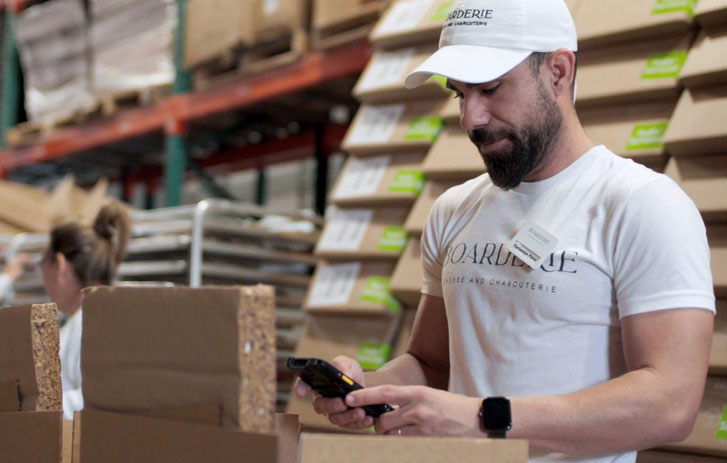How to optimize order fulfillment
Optimizing fulfillment reduces the number of man-hours it takes to fill orders. And that can save your business money. It also helps your team efficiently and accurately get orders out the door.
Getting the most out of your fulfillment means auditing your warehouse and processes. When you do, you’ll evaluate aspects of your labor, facilities, workflow and procedures, and software.
Optimizing fulfillment reduces the number of man-hours it takes to fill orders. And that can save
your business money. It also helps your team efficiently and accurately get orders out the door.
Getting the most out of your fulfillment means auditing your warehouse and processes. When
you do, you’ll evaluate aspects of your labor, facilities, workflow and procedures, and software.
Goals for optimizing fulfillment
Reduce the number of times a human has to touch a product and footsteps a person must take to fulfill the order.
Cutting down these things reduces the amount of time each worker needs to pick and pack each order. This lets you schedule fewer workers, or simply get much more productivity out of the same workers.
Reduce the number of times a human has to touch a product and footsteps a person must take to fulfill the order.
Cutting down these things reduces the amount of time each worker needs to pick and pack
each order. This lets you schedule fewer workers, or simply get much more productivity out
of the same workers.
Focus on the things you can change.
For example, maybe you’re paying more for workers because of the labor market near your warehouse. You can’t change the labor market, but you can rearrange your warehouse to require fewer workers.
Focus on the things you can change.
For example, maybe you’re paying more for workers because of the labor market near your
warehouse. You can’t change the labor market, but you can rearrange your warehouse to
require fewer workers.
Prioritize optimization for
fast-moving products.
Sort your inventory by picking size (pallet, case, or piece). Then classify the products by how fast they sell — fast, medium, slow, and very slow. Did you know that 80% of your sales probably come from your top-selling 20% of SKUs?1 If changes seem overwhelming or are slow going, concentrate on making the changes that affect your top-selling 20%.
Prioritize optimization for fast-moving products.
Sort your inventory by picking size (pallet, case, or piece). Then classify the products by how
fast they sell — fast, medium, slow, and very slow. Did you know that 80% of your sales probably
come from your top-selling 20% of SKUs?1 If changes seem overwhelming or are slow going, concentrate on making the changes that affect your top-selling 20%.
5 Steps to assess your fulfillment2
Use this free fulfillment audit checklist to guide your assessment. It goes in depth
how to evaluate your labor, facilities, workflow and procedures, and software.
Do a walk-through.
Pay attention to more than just how orders are picked. Note where workers are delayed and bottlenecked. Where are they taking extra steps to get the product and bring it back? Pay attention to lighting, general cleanliness, morale, and pace. Clean, well-lit warehouses are more efficient. And they’re safer. Morale and pace can give you an idea of how your teams are faring.
Do a walk-through.
Pay attention to more than just how orders are picked. Note where workers are delayed and
bottlenecked. Where are they taking extra steps to get the product and bring it back? Pay
attention to lighting, general cleanliness, morale, and pace. Clean, well-lit warehouses are more
efficient. And they’re safer. Morale and pace can give you an idea of how your teams are faring.
Gather data.
Gather order accuracy, customer service complaint, order turnaround, and inventory control reports. Add in any quality assurance reports you’ve commissioned, such as secret shopper reports and customer satisfaction surveys. The data should give you an overall picture of any places your fulfillment is lacking. In step 5, you'll analyze the data you've gathered.
Gather data.
Gather order accuracy, customer service complaint, order turnaround, and inventory control reports. Add in any quality assurance reports you’ve commissioned, such as secret shopper reports and customer satisfaction surveys. The data should give you an overall picture of any places your fulfillment is lacking. In step 5, you'll analyze the data you've gathered.
Interview staff.
Ask your team leaders about their ideas for growth and efficiency and then talk to the workers on your warehouse floor. They’re the boots on the ground. They see where
problems are.
Interview staff.
Ask your team leaders about their ideas for growth and efficiency and then talk to the workers on your warehouse floor. They’re the boots on the ground. They see where problems are.
Analyze reports and benchmark.
It’s time to dive deep into the data you’ve gathered. What conclusions did you find? You’ll also want to use outside benchmarking to see how your company is performing. Compare your stats to companies of similar size that sell similar products.
Analyze reports and benchmark.
It’s time to dive deep into the data you’ve gathered. What conclusions did you find? You’ll also want
to use outside benchmarking to see how your company is performing. Compare your stats to companies of similar size that sell similar products.
Make recommendations and
take action.
Write a report with your conclusions and suggested changes. Break changes down into detailed action steps. Sort your changes. Put the ones with the most impact on your business first and implement improvements slowly. It helps reduce disruption and lets workers get used to changes. Assign someone to be accountable for each step, provide an expected completion date, follow up on changes. You’ll want to see what worked and what
needs improvement.
Make recommendations and take action.
Write a report with your conclusions and suggested changes. Break changes down into detailed action steps. Sort your changes. Put the ones with the most impact on your business first and implement improvements slowly. It helps reduce disruption and lets workers get used to changes. Assign someone to be accountable for each step, provide an expected completion date,
follow up on changes. You’ll want to see what worked and what needs improvement.
Get help for your small business
Chat with a FedEx expert, request a phone consultation, get how-to guides, and more. Get help now.
Chat with a FedEx expert, request a phone consultation, get how-to guides, and more. Get help now.
Related reading

Boarderie’s recipe for success
Learn how Boarderie used e-commerce during the pandemic, partnering with FedEx to deliver fresh, artisanal cheese and charcuterie boards nationwide.
Read Article
Businesses enjoy reliable international shipping
Consumers who have a satisfying shopping experience are likely to become repeat customers. FedEx International Connect Plus can help make that happen.
Read Article
Choose the right ecommerce platform
Get tips to help you choose the right sales platform for your small business.
Read article1 Source: Kardex Remstar
2 Source: F. Curtis Barry & Company